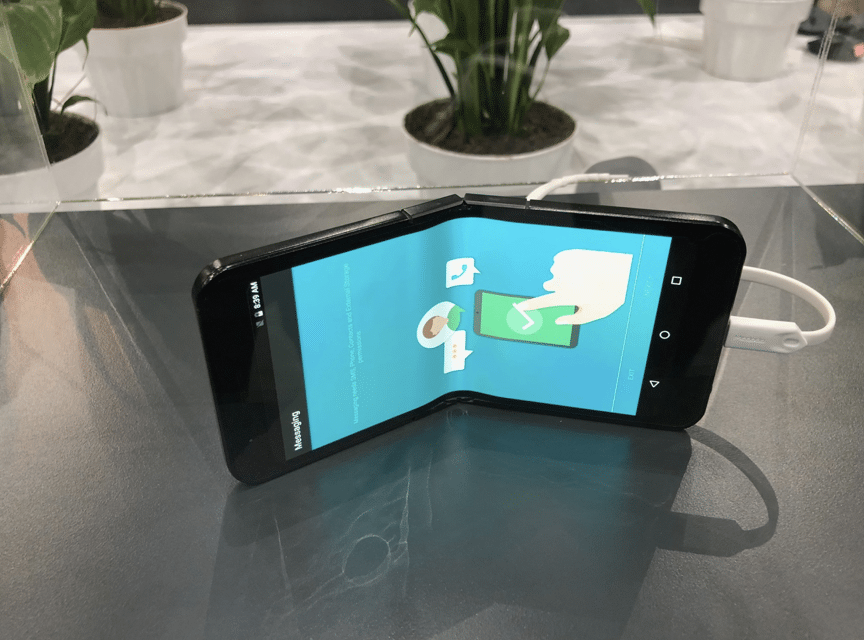One of the things I learned early in my career is that if you want to get a glimpse of the future, you need to go to technology trade shows that are focused on components and are deeply entrenched in the world of engineering. It is at these shows you get to see technology being developed in early stages as well as technology that is just about ready to be used in new tech devices in the next year or two.
One such show is the SID ( Society for Information Displays) conference that took place last week in Los Angeles. This show is dedicated to the world of display technology and showcases all types of displays including next-generation OLED’s for TV’s, Laptops, etc as well as the star of this years show, the newest things in flexible and even rollable displays.
Visionex kicked off the event with a keynote that highlighted their foldable display in a video, but I did not see an actual model in their booth. On the other hand, BOE, one of the largest makers of displays in China, showed off two types of mobile devices that were using real working models of their flexible display. In the picture below, BOE had created a smartphone with a display surface of close to 9 inches and folded completely in the center. What was amazing is that even in the folded position, the image and videos they showed worked flawlessly.
The second phone they showed had an actual bendable screen. The phone was about 5.5 inches but folded in half to make a smaller device that is easier to carry.
I saw a few other flexible screens under NDA but it is clear from this show that the next really big thing in smartphones will be around new designs that include some type of flexible or foldable display.
If you look closely at the BOE flexible display in the first two pictures, you can see the reason why foldable displays matter. Our smartphones today pretty much top out at 6″ inch screens and that is the total viewing space for what we see and consume. With BOE’s flexible display you could add about 3 more inches in viewing space and that makes it closer to a tablet. Think of it as having a tablet that fits in your pocket.
The flexible or foldable display in the third picture allows you to actually shrink the size of the smartphone to a foldable package that could be about 3 inches, but when unfolded, it would deliver a full 6-inch smartphone.
While these screens were early demos, I am told that seeing flexible displays in smartphones is not that far off. In fact, we could see one in a smartphone from a major manufacturer in early 2020. My best guess is that given the challenges in actually making these flexible screens in high volumes, we might not see them have a dramatic impact on smartphone designs until 2021-2022, but I am assured that these flexible screens will be in smartphones easily by then.
In the short term, the smartphone industry is well on its way to giving us an interim approach to larger screens on a smartphone using a dual screen design. By early 2019, we will begin to see many smartphones with dual screens that, when opened, double the size of the viewing space. In this case, you will be viewing two screens and thus have two displays to use to see content. There will be a seam in the middle that separates the dual screens in contrast to the smartphones with flexible displays in which the content is delivered on a single display.
What is interesting about these dual screens in the works is that they will come in many display formats. I am hearing we will see dual screens that when opened up span between 6 inches and 13 inches. The larger ones are focused on tablet formats while the smaller ones can double as a smartphone/tablet combo.
Another new concept in displays at SID was shown by E Ink. E Ink is best known for supplying the electronic digital paper display that is used on Amazon’s Kindle book reader. In the picture below, they showed a prototype of a rollable display using their digital paper display.
The Rollable display is only in black and white but it was an interesting twist on electronic digital paper. I also saw their color E Ink screens that are destined to be used in all types of advertising displays in stores and any place where signage needs to be changed or updated on a continual basis.
While I do think that AR and Mixed reality glasses tied to a smartphone will have a more revolutionary impact mobile computing eventually, the introduction of flexible and foldable displays is important to advancing the designs of smartphones in general. I personally like the idea of having a smartphone that when opened up could become a tablet too.
We are still a few years away from commercializing and mass producing this technology. It will be interesting to see how consumers respond to some of the first implementations of foldable displays. While it may come off as a gimmick at first, this is the kind of technology that will allow us to have the biggest screen possible in our pockets at all times. There is no doubting the value in that.



Nice post. I learn something new and challenging on blogs I stumbleupon on a daily basis.